Anatomy of an Aid Station
Volunteering at the Hardrock 100 highlighted some essentials for ultra prep and mid-race management
Thanks for visiting my weekly publication; please subscribe if you haven’t already!
Friday morning at 6 a.m. I’ll embark on the High Lonesome 100, a giant loop around the Sawatch range with 23,500 feet of elevation gain. As I make my way along the Continental Divide and Colorado trails, I’ll follow the ultrarunner’s adage, “Take it aid station to aid station.” In other words, break the effort into smaller segments and focus only on getting to the next aid station. Don’t stress about the entirety of the miles still to run.
Combining elements of a shelter, cafe, and pep rally, aid stations provide essential assistance, energy, and encouragement to ultrarunners, especially in extra-long events that run through the night. While it’s possible and admirable to do a self-supported ultra, in my mind that’s a bit like self-study versus enrolling in a vibrant class—you enhance self-reliance and go your own way, but you miss out on camaraderie and support.
Last Friday, I worked an aid station in a remote mountain setting outside Silverton, elevation 11,000 feet, at mile 58 on the Hardrock 100 route. The 24+ hours spent there for setup and runner aid enhanced my appreciation for what makes an aid station function well and how volunteers can revitalize bedraggled, exhausted, aching runners.

The Evolution of the Aid Station
Aid stations date back to 1978, when runners and riders involved with the Tevis Cup 100-mile horse endurance ride decided to make the 100-mile run, started in 1974 by lone runner Gordy Ainsleigh, a separate event held a month earlier than the Tevis—the now-iconic Western States Endurance Run. (From 1975 – 1977, a small number of runners ran Western States on the same day as the Tevis, alongside the horses.)
A founder of Western States, Mo Livermore, told me in an interview several years ago that she and a few others spent the spring of ’78 driving the high country along the Western States trail trying to figure out where to put checkpoints with water and minimal aid for runners. “Then we begged all our friends to man an aid station,” she recalled. “They’d say, ‘A what?’” In other words, “aid station” was a brand-new concept in ultra-distance running.
What were those early aid stations like? “In the high country we probably only had water. At other checkpoints, we served ERG [an electrolyte-replacement and glucose drink] early on, and probably had cookies and fruit,” Mo told me. “A couple of years into the run, probably in 1979 or ’80, Larry Griffith, who was manning the aid station down at Bath Road, got Campbell Soup to donate some soup, and that was huge! That was so innovative, to get a donation of soup.”
When I started running ultras in the mid-2000s, aid stations consisted of folding tables loaded with a buffet of junk food, cut-up fruit, PB&Js, and liters of soda poured into hundreds of wasteful Dixie cups. I discovered how delicious a PayDay candy bar (something I’d never eat on a normal day) tasted mid-run. With little regard for germs, everyone stuck their grubby hands into the same communal bowls or plates to grab snacks. At most ultras, aid stations were more about providing food and hydration than about shelter and medical care.
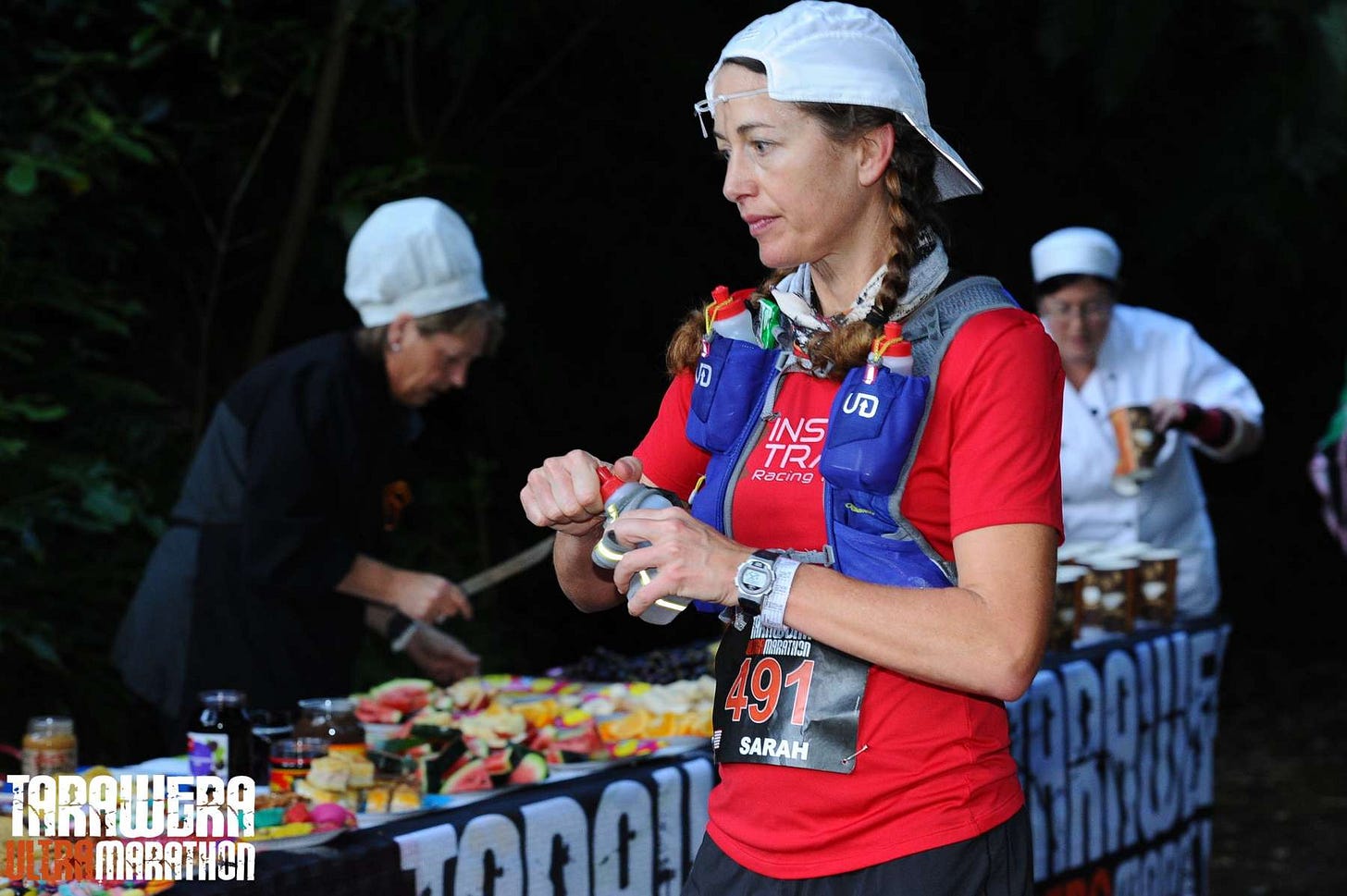
The Best and Worst of Aid Stations
I’ve experienced the best and worst of aid stations. An example of the best: When I ran Western States in 2016, I was treated to that event’s “concierge service” of one volunteer assigned to each runner, so that when I’d enter an aid station, a helpful volunteer would step forward and commit to getting me whatever I needed. He or she would pack my arm sleeves with ice to cool off, refill my bottles, rub sunscreen on my limbs, and then tempt me with a variety of food. This one-on-one service, which Hardrock also strives to provide, is incredibly helpful and can only happen if the organization recruits enough volunteers.
Just last month, I experienced the best in aid station fare and friendliness. At the San Juan Solstice 50, volunteers had cooked homemade soups and pasta dishes, in addition to dishing up more standard aid station snacks. The degree to which the small town’s community supported this event really touched me.
And an example of the worst? I won’t name the event, because its race director has worked so hard to develop it, but when I ran it a few years ago, the management had major kinks to work out in aid station supplies and staffing.
At one aid station in the first half of the extremely tough mountain route, a single harried volunteer with a bare-bones setup of a folding table and only partial cover from the rain offered slim pickings of packaged cookies, sour-cream-and-onion flavored potato chips (the kind of strong flavor a runner does not find palatable mid-ultra), and a dwindling supply of ginger ale. At least I could refill there. Later, I heard that a runner toward the back had dropped because he arrived at that aid station dehydrated, and the station had run out of water.
That struggling aid station was a reminder to be as self-sufficient as possible, especially at newer races in remote and rugged settings. For example, carry enough snacks and consider a water filter to refill at streams, along with basic first aid (such as self-adhesive wrap for a rolled ankle or a cut). It’s especially important when running inaugural events to be more self-sufficient in case of race management’s first-year snafus.
What Made Hardrock’s Animas Forks Aid Station Run as Smoothly as Kilian
I’ve volunteered at many aid stations over the years, none as elaborate and effective as this Hardrock one.
When I arrived last Friday morning to the setting of the Animas Forks Aid Station, a crew had already set up two big tents—the kinds with thick white canvas supported by poles and used for special events. But we had additional pop-up tents to erect and truckloads of supplies to unload.
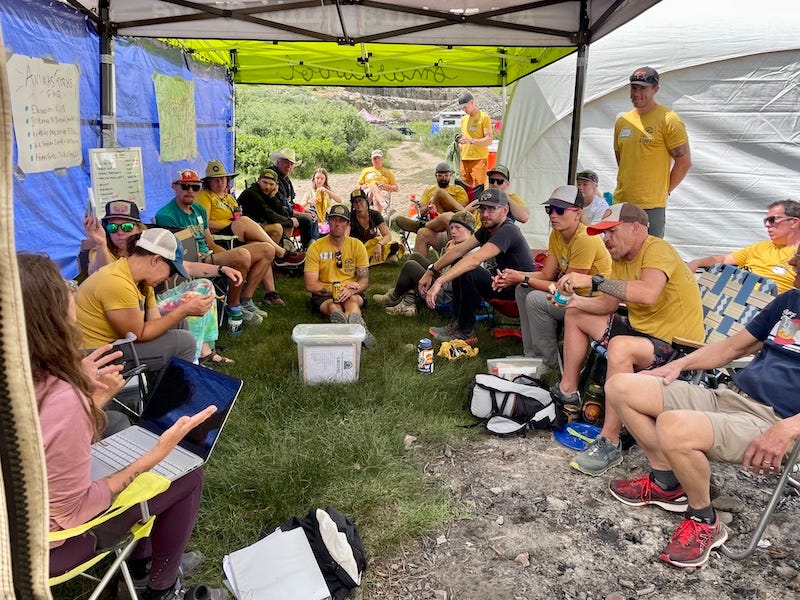
All of this setup unfolded smoothly thanks to the organization of the aid station captain, Julie Blanda, in her fifth year of volunteering for Hardrock. Julie had the added challenge of setting up this aid station for the first time in a new location (it replaced Hardrock’s Grouse Gulch Aid Station from prior years), and therefore she had to figure out tent placement, traffic flow, and myriad organizational details in the new setting.
Julie is a seasoned aid station manager who works for Aravaipa Running, and her leadership skills earned my attention and respect. Her communication style might be described as a cross between a hard-ass, by-the-book law enforcement officer and an uplifting cheerleader like Tim “make it work!” Gunn in Project Runway.
At one point, Julie was barking “You must turn around!” at a car filled with front-runner Francois D’Haene’s crew because they had cluelessly driven the wrong way against the aid station’s one-way traffic control. Then she yelled at them and for everyone else to hear, “Every runner is treated the same at my aid station! Every runner is the same!”
Minutes later, she was hollering to all volunteers, “We’ve never had this much tent space—it’s amazing—it’s like a mansion! This is fucking awesome! I love you all!”
Our team of volunteers laid out the aid station like a terminal with distinct parts. At the entrance, a timing tent staffed with volunteers checked runners in and out. Then a tent full of runners’ dropbags stood near with volunteers ready to find and hand out a bag. Next came the kitchen tent, staffed by skilled cooks and servers offering an elaborate menu of hot and cold, and savory and sweet, food and beverages, with a dishwashing station set up next to it. Then a medical tent with cots, chairs, and three medical personnel, flanked by tents with numerous chairs where runners could sit, eat, and get organized. Gas generators powered the lights, portable heaters, and music; propane powered the stoves. A campfire added warmth and ambiance, thanks to the rainy weather lifting the area’s fire ban.
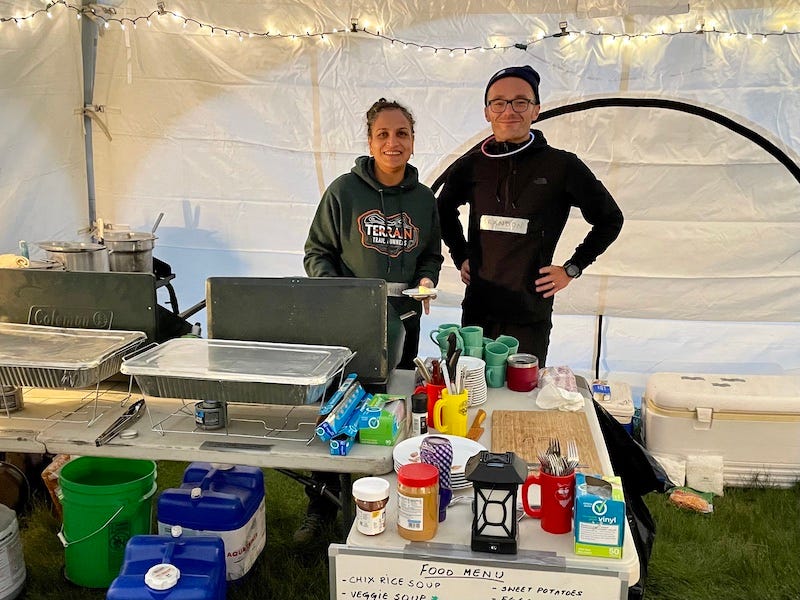
The frontrunners including Dakota, Francois, Kilian, and Courtney didn’t bother with any of the aid station’s offerings. Their crew stationed themselves on the road next to the entrance, pulling gear and coolers in specialized little wagons, so all these elite runners had to do was check in at the timing tent. Then their crew team would attend to their every need roadside as quickly as possible.
Then the midpackers started to trickle in, and around midnight, that trickle became a flood. When I saw the beam of a headlamp approach the aid station, I’d connect with that runner and identify myself as their helper. Usually they had a pacer and perhaps additional crew with them; I nicely but firmly had to manage crowding by asking that only one of their supporters accompany the runner into the aid station tents.
Then I moved in triage mode. As quickly as possible, I’d get a blanket or towel to wrap around their shoulders or legs to prevent catching a chill; I’d help them take off their shoes and wipe their feet if they needed a sock change; I showed them the food menu and asked what they wanted, and then I’d go get the food and drink.
As night gave way to daybreak, my role shifted to counselor as much as nurse or server for the back-of-the-packers who needed encouragement to keep going. I helped one man prop up his blistered bare feet, and I wrapped him in a blanket and placed a potato-egg-bacon tortilla wrap on his chest to entice him to eat. He snoozed for a bit and then endured the discomfort of a medical staffer trying to pop blisters too deep in the dermis to effectively drain.
We chatted intermittently, and I kept telling him his feet would feel fine once he got moving. “The pain will numb out. You’ll feel so much better when you see the sun rising over Handies,” I said.
“But I’m not sure I’m going to get going,” he said. And he continued to sit. I kept checking in with him, encouraging him to leave with another runner who was rallying to hit the trail.
He spent over 90 minutes at the aid station. Then, finally, he roused as if to leave. I and others cheered for him to get out of there and get back on the trail. This runner, Peter Lawson, got the honor of finishing “DFL” (last place), less than three minutes before the final cutoff.
How to Get In and Get Out
You can learn a lot about a runner by observing how they manage their gear and take care of themselves at aid stations. By Mile 58, many still have their race dialed in and their shit together. Others arrive looking and acting like a mess, fatigue and nausea having erased their cognitive capacity to get what they need and to triage their problems.
The successful runners entered the aid station with a mental plan of what they needed to do and eat, and they acted with polite and business-like efficiency. They were relatively pleasant, not brusque, and thanked the volunteers. They knew what they needed for the next 10-mile stretch over the 14’er Handies (e.g. warmer layers, fresh batteries in a headlamp, full bottles for hydration), and they got food and ate with a sense of purpose.
The strugglers, however, moved as if in slow motion and dense fog. What should they eat? Nothing seemed appetizing, and after they sat down, they couldn’t rise again to get food. What should they get from their dropbag? They weren’t sure.
The way they dug through their belongings reminded me of the most frazzled and disorganized travelers in airport security lines. Suddenly their shoes are off, their bags are open, they have too much to carry, and their items have scattered in all directions.
As I watched the runners and their crew, I made a mental list of what I should and shouldn’t do at aid stations during my ultra this weekend. I want to get in and out like my friend Stephanie Case, who in a mere nine minutes at our aid station managed to sit and eat—I think she choked down some bacon and part of a burrito—and reorganize her pack to fill bottles and clear it of trash. Then she was up and outta there. She ended up finishing 2nd Female and 19th overall, sandwiched between two top-level guys I admire, Jason Koop and Jamil Coury.
By contrast, another friend who shall remain nameless arrived dazed and confused and spent 52 minutes at our aid station. This person needed a 20-minute nap on a cot, then slow rousing to sit up and eat something. A too-long deliberation ensued over what to wear and carry for the next segment. This person dug through multiple drop bags, searching baggies nested within baggies, for a few very specific items that struck me as nonessential. I tried to be supportive and suppressed the urge to shout, “You’re fine, get going!”
For ultras that feel like odysseys, it may seem necessary to pack everything in drop bags in case of worst-case scenarios. Try to keep it simple and avoid packing as if you’re a through-hiker on a two-month trek. Excess stuff leads to complicated decision-making about what and what not to use.
What’s In a Bag?
By 8 a.m. Saturday morning, only a few stragglers chasing cutoffs were still coming into the aid station. It was time to start packing up. I loaded my truck with dropbags to transport back to the finish line for runners to retrieve.
The bags looked as varied and individual as the runners. A few seemed pathetically pointless, like one person’s gallon-sized Ziploc that contained a baggie of goldfish crackers, some gummies, a toothbrush, and mini-sized tissues. I wondered aloud, “Did his mommy pack his dropbag for him?”
I mean, while I understand it’s refreshing to brush your teeth midway through a 100-miler, why bother with this kind of snack bag when the aid station offers similar crackers and candy?
Other bags were roomy Tupperware containers that looked like they meant business, as if the runner were a litigator carting files into a courtroom.
My favorite “bag” that reflected the runner’s no-frills personality belonged to Hannah Green, who finished 3rd Female just behind Stephanie. Hannah, a mountain adventurer and writer, made the gutsy move of running Hardrock without a crew or pacer. Instead of a bag, she used a plastic 5-gallon bucket from Home Depot. Sturdy and waterproof, its pocket-less interior made it easy to see and grab anything that was in there. Hannah had used these buckets last spring for caches while hiking the length of the Grand Canyon.
Now that’s resourceful—buckets for bucket-list adventures!
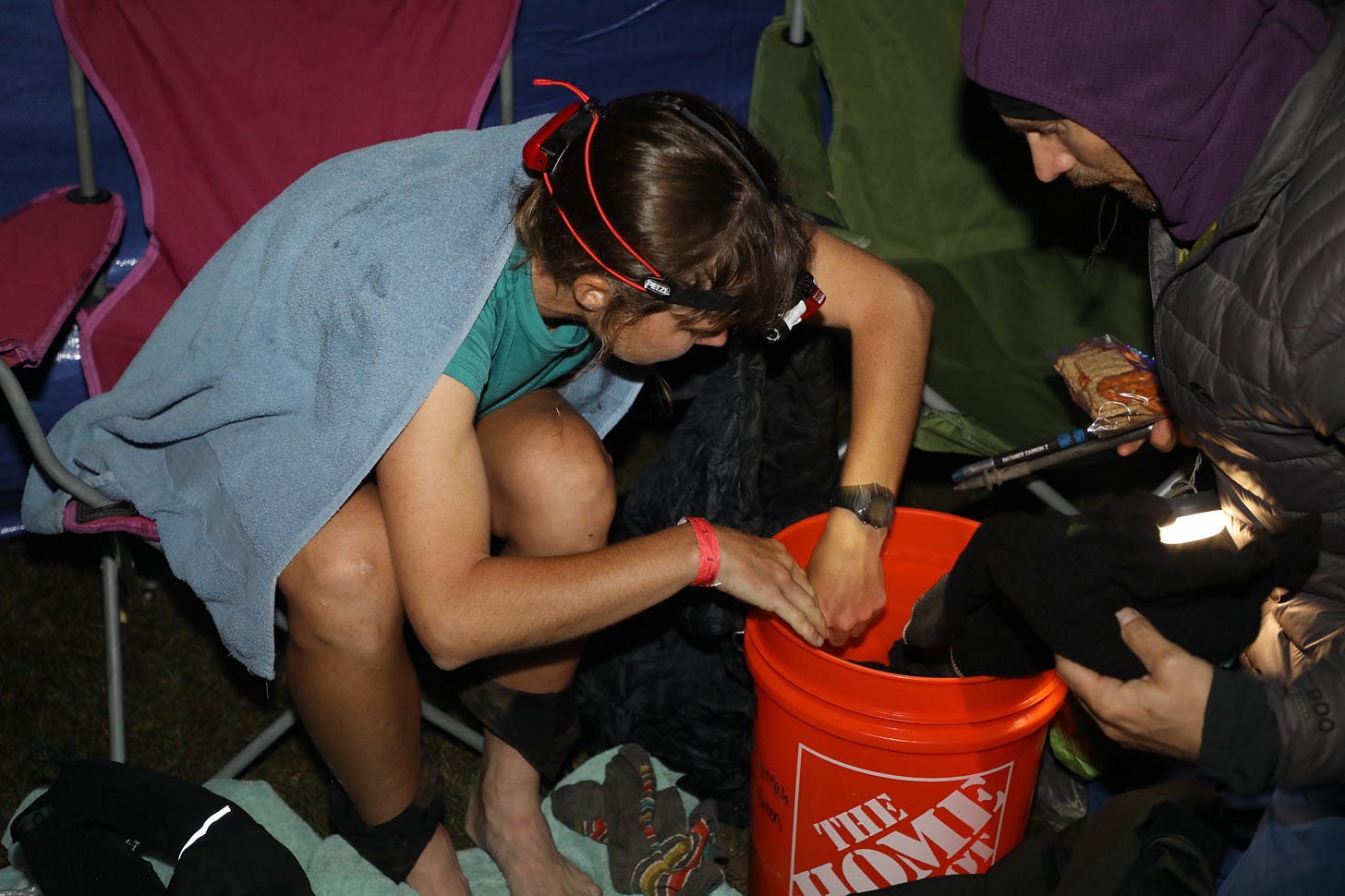
Bonus: If you have not seen the classic and hilarious “Mystery Dropbag Challenge” produced by Jamil Coury of Mountain Outpost, watch it here.
Looking Ahead to This Weekend
Speaking of dropbags, I have to finish packing mine and hit the road. I can’t adequately describe right now the clash of emotions swirling inside as I contemplate starting the High Lonesome 100 in less than 48 hours. My hope is to do better—and pace better—than last year, when I ran the first half at a strong sub-32-hour pace, then slowed considerably and napped in the second half for a finish closer to 34 hours. My hope is to finish around 32:30. If you’d like to learn about the event, check out my report in UltraRunning from last year, and Friday through Saturday you can check my progress here; I’m bib #54.
Finally, I want to link to an incredibly meaningful and moving short documentary film that came out about Free to Run and Stephanie Case. I’ve known Stephanie for a decade and am proud to have supported Free to Run since its founding. This film, a year in the making, focuses on Free to Run’s mission to empower women in Afghanistan and captures how Stephanie handled the crisis of the Taliban’s takeover and the threats to the organization’s staff—all the while she was training for and running the Tors des Glaciers 450K (279M) ultra in Europe. I believe the filmmakers are planning to release a full-length version and this is their shorter cut. I hope it lands in a lot of film festivals. Please watch it here and consider supporting Free to Run.
Related posts:



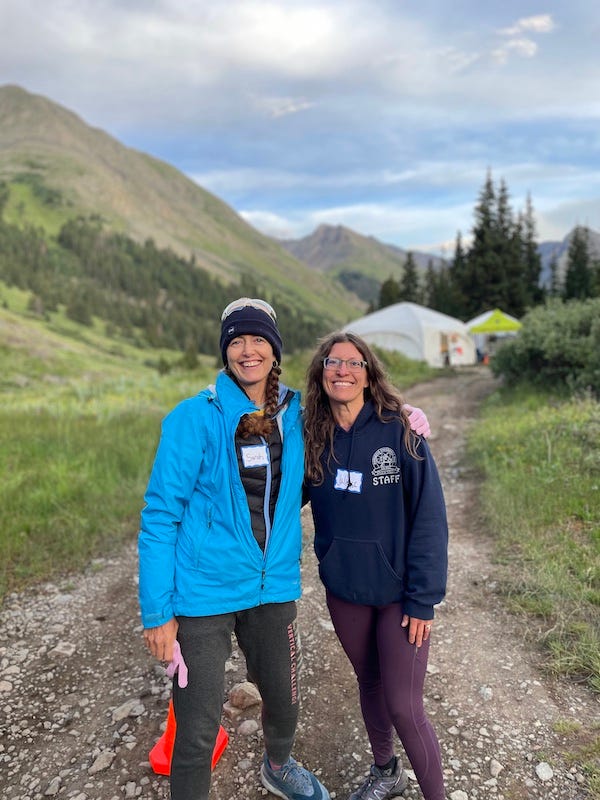


Thanks for the shout out and the tough love. That DFL was my proudest finish. -Peter Lawson.
Enjoyed your article and the others you have wrote.. I did the R2R2R 2 years ago at 60, mid October solo. It was an unforgettable experience for me and most surly for you also. I have been at your aid station and it is first class. Last year I came through as a pacer and the year before waiting for my runner that didn't make it and I went up and found him. Maybe our paths will cross this year at Hard Rock.